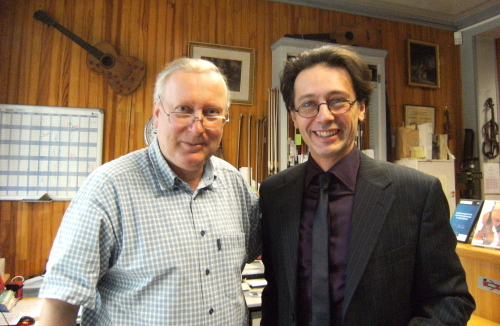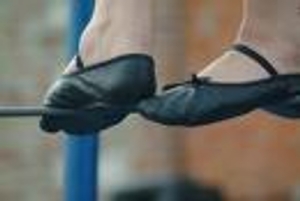VISIT TO THE MOUNT OLYMPUS
This week, Instead of speaking about the problems occurring when a bow had too much or too little curve, I would like to talk about my visit to the Mount Olympus.

Mr. J.F. Raffin – current founder of French bowmaking
In this case the Mount Olympus we are speaking about means the top of the world bowmaking: B. Millart, old founder of the French bowmaking and J.F.Raffin, his scholar and current founder and L.Le Canu, the possible follower. These three persons represent the first, second and third position of the bowmaking and only the first two of them have the right to issue certificates on the French bows. The topic “certificates” is very important, in particular when it refers to French bows and I will come back on it at the soonest, so to clear up things in a world that is a little bit “messy”.
Anyway, coming back to our today’s topic, I went to visit the 3 big founders and introduce my new workshop by submitting them a violin bow made by M° Navea Vera. I wished to compare with the best ones so to receive precious suggestions from their side on how and where our work could be improved. I had great expectations but the result has even exceeded them.After having examined the bow, none of them had any note to do, regarding both mechanic and style, but they expressed their appraisal for the excellent work and the choice of the wood. The unanimous comment has been “ Congratulations for the excellent work! “ M° Navea Vera and I shared a huge happiness, as you can imagine, we have passed the exam of the toughest commission possible but we left it with the academical kiss on our forefront; we could not have asked for more.
After this little diversion, for which I hope in your forgiveness, we come back to the right amount of the curve, speaking about “balance”.

Pernambuco wood is used in bowmaking for its great elasticity and the strength of its fibers that allow to launch the sound much further than with any other wood. Just to name one “snake wood”, that was very used in the baroque period for both its beauty and the high density that permits to create a very smooth sound, but because of its low elasticity, the sound is not launched very far.It is normal that a wood like Pernambuco, owning such a lively and wavy character, needs a very fine and precise mechanic to be adopted; an old advertisement said “Power without control is nothing”. The control of a bow pass through the curve for what we could call “a traction control” as already explained in the previous blog (THE CURVE) as well as for the stability, i.e. the balance.
Imagine for a while to be a tightrope walker, if you have ever watched one of them, you must have noticed that the ropes where these acrobats walk are never too loose or too stiff but they are flexible in the proper way. The reason why this tension is so important is that it greatly affects the balance relation between rope and tightrope walker.If the rope bends in a proper way, the athlete has the possibility, waving his body on one side, to slightly increase the surface on which he can balance his bodyweight in better way in relation to his height. But if the rope is very stiff or very loose every tightrope walker, even the most clever, will meanly fall down because the proper relation between weight and height will be affected. With a too lose rope, the athlete will be compelled to keep his balance with huge swingings and the wrong relation will cause him to fall down.On the contrary, a too pulled rope cancel any elasticity making any swinging impossible with the consequence of an unavoidable fall. Opposite problems but same result.
I made my example with tightrope walkers because in the bows as well the architectural balance is ruled by the same laws. A bow that owns too much curve in fact, apart from becoming to smooth and keen to “dance” owing to the barycentre placed too low in relation to the height of head and frog, will tend to “wave”. In other words, when you will discharge the weight from your arm, in the point where the curve reaches his maximum extension, the stick will have the tendency to divert on one side.If the curve is scarce, the strength will increase and, as already told, the capability to jumpwill be decreased. The poor amount of curve will sharply increase the stiffness of the stick , reducing the possibility to feel the string, therefore if we spoke previously about the too low barycentre that will cause a wavy bow, in this case it will be too high and consequently it will fall on one side.
We have thoroughly spoken of the right curve amount but since the topic still need to be deepened, next time we will speak about “THE CURVE AND THE BALANCE”
So long
Paolo
|
 
 |